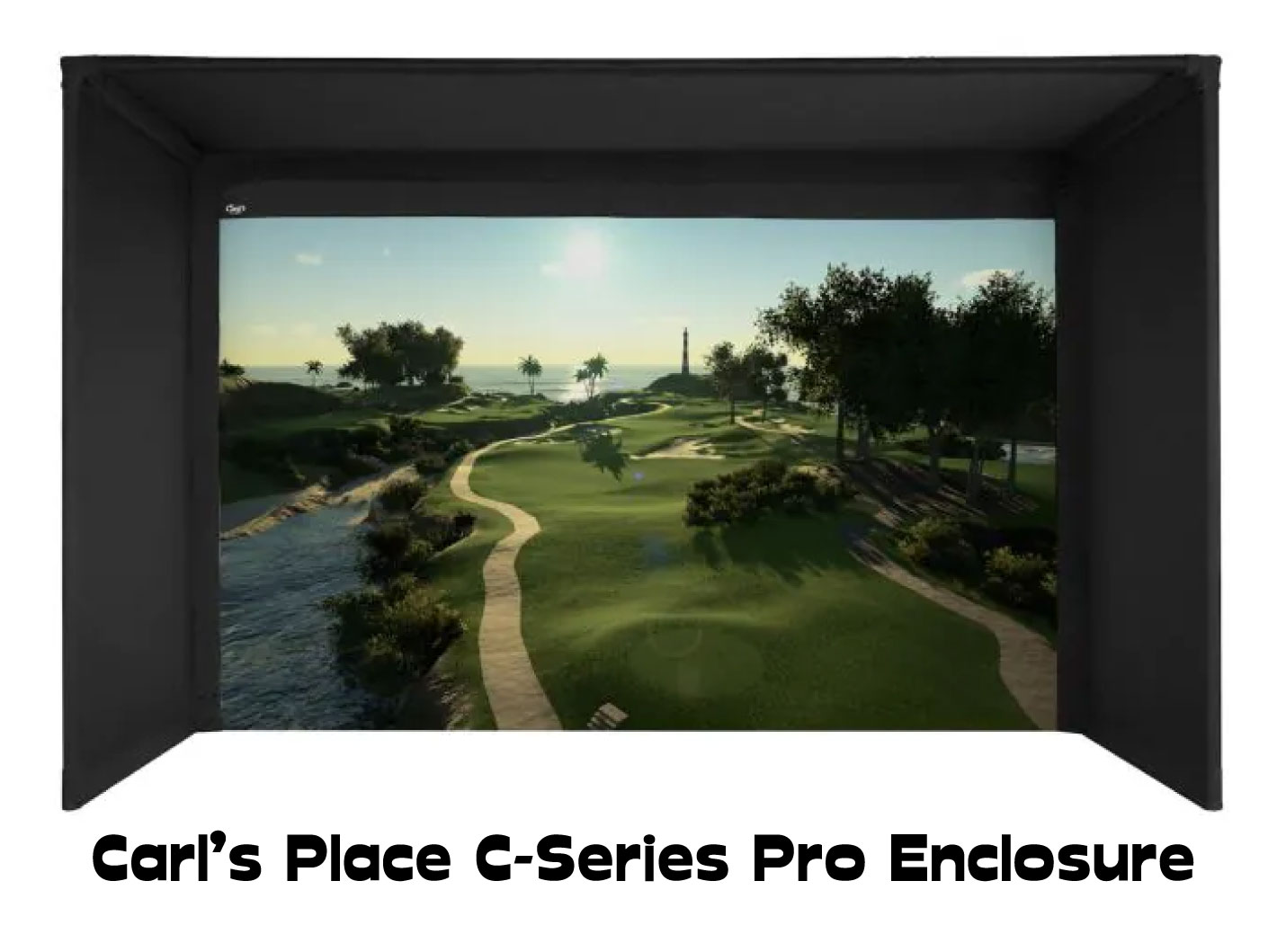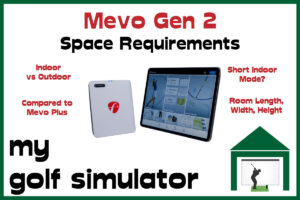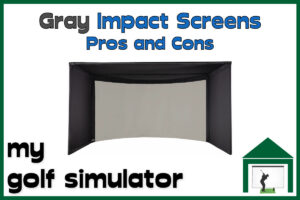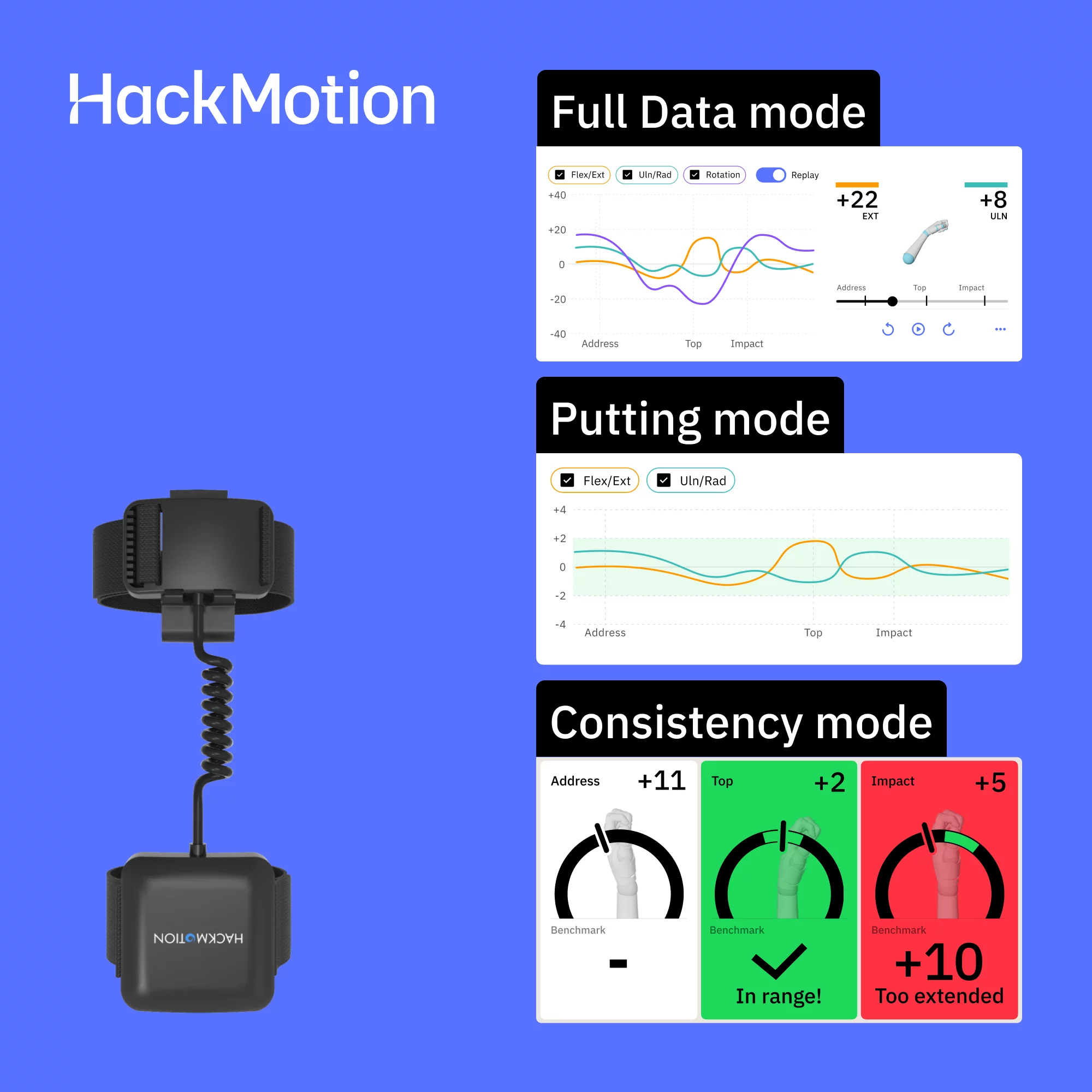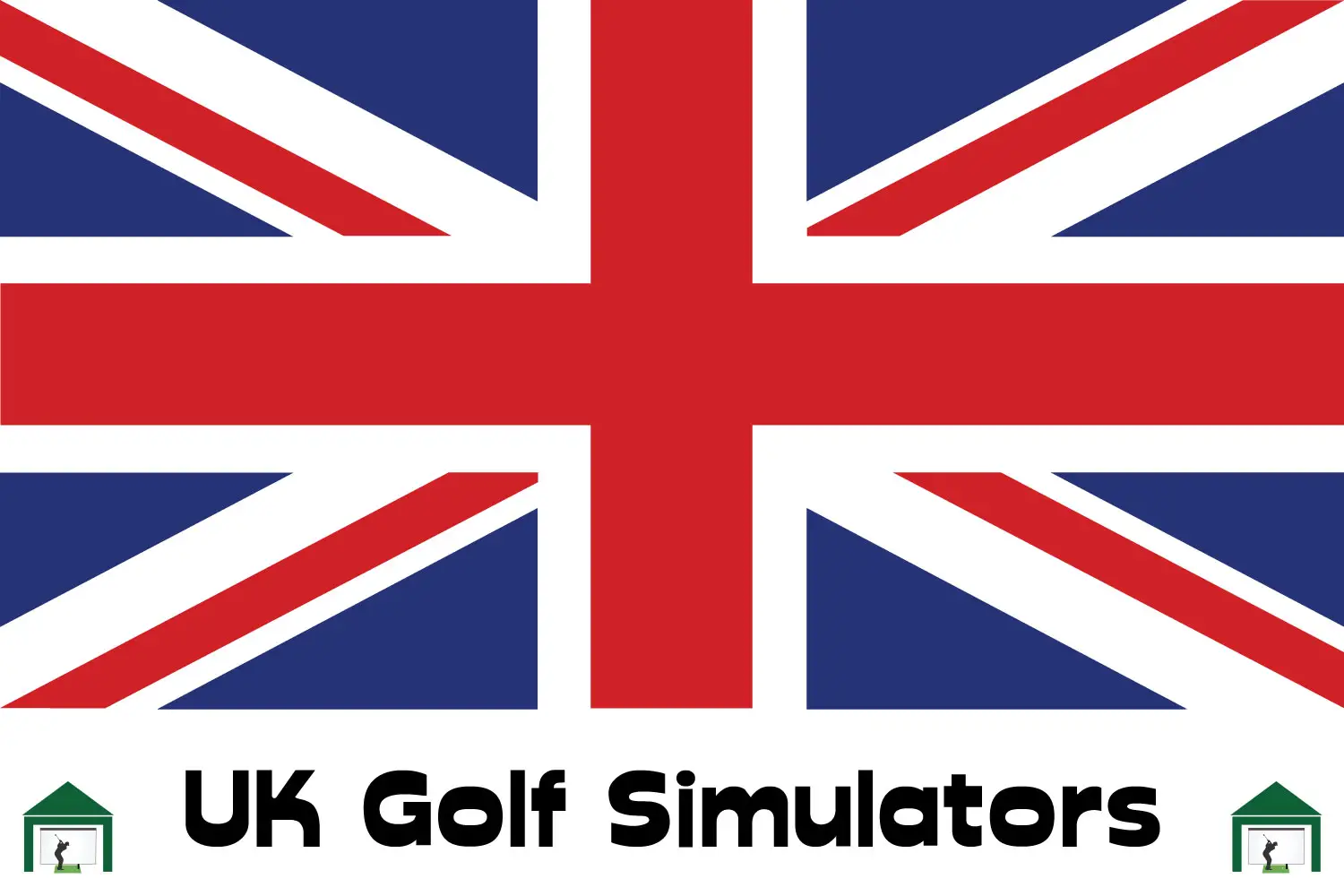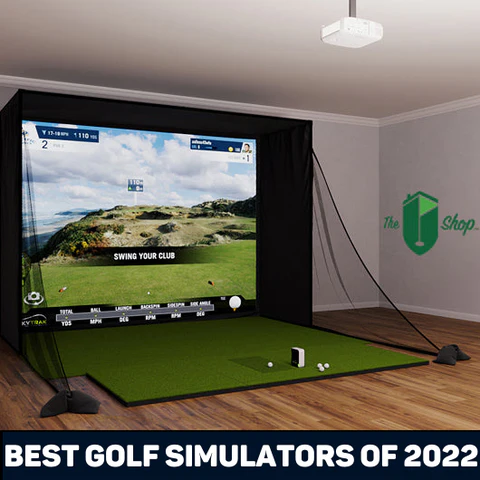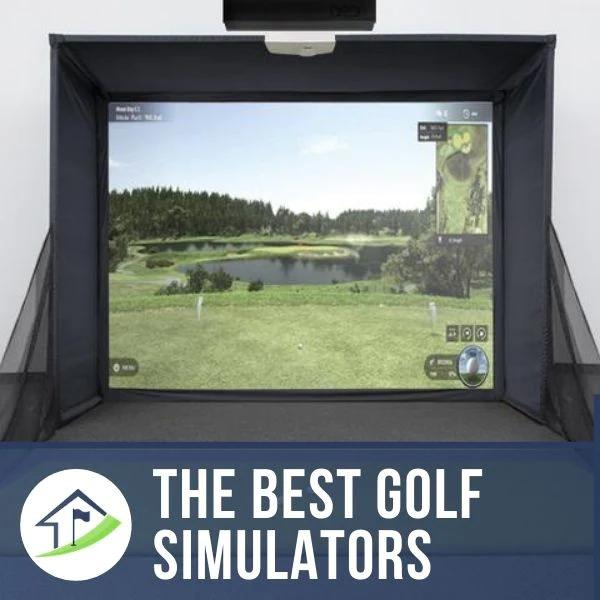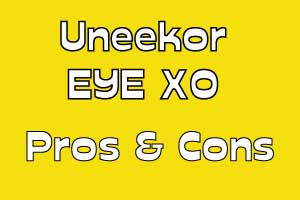What is the perfect golf simulator projector throw ratio?
Posted in Projectors, Room Setup
You need to ensure your golf simulator projector throw ratio is correct for your simulator bay. If you get it wrong you may be unable to use your projector for your golf simulator at all. Read our guide to pick the right one.
You need a short-throw projector. This means a throw ratio of between 0.4-1.1. This range lets you mount the projector 8–14 ft from the screen, avoiding shadows and keeping it safely out of your swing path. A standard throw projector will need to be mounted much further from the screen for the same image size.
For example, a projector with a throw ratio of 0.5 will give you a horizontal screen image of 15ft wide (in 16:9) when mounted 7ft 6 inches from the screen.
We explain what these terms mean and their impact on your golf simulator in this article.
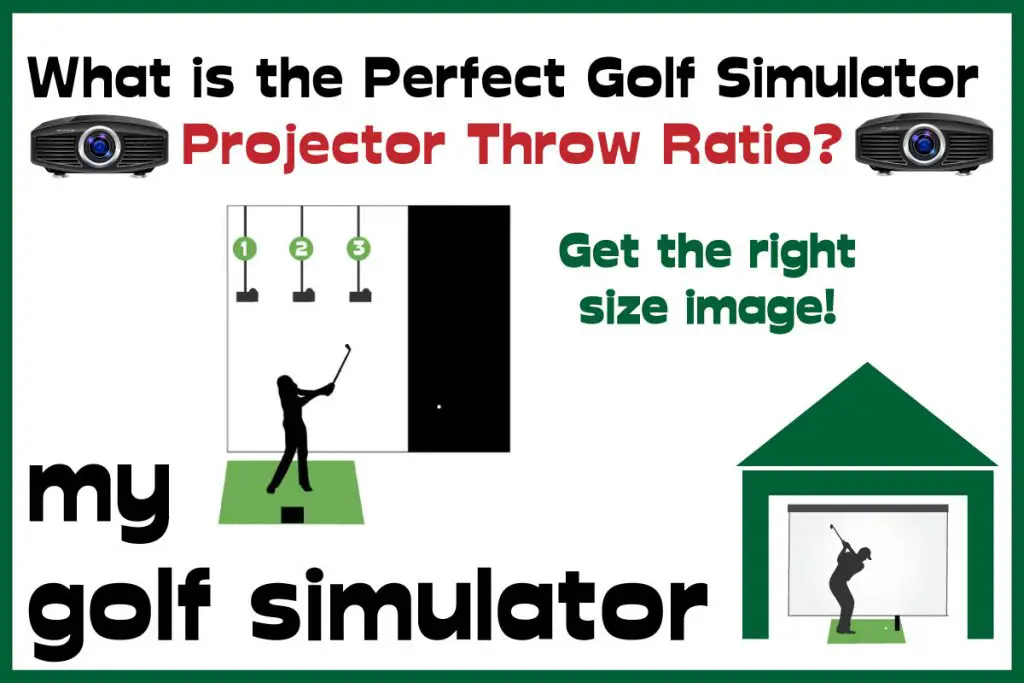
What is a projector throw?
When discussing golf simulator projectors, ‘the projector throw’ refers to the ‘throw ratio’.
A simpler term you need to understand first is the ‘throw distance’, this simply means the distance from the projector to your screen. For any given projector lens, the image on the screen will get bigger the further away the projector is.
The throw ratio is the ratio of throw distance to horizontal image width projected by the projector. The height of the image would be determined by the aspect ratio.
Some projectors have ‘zoom lenses’ which means that you can increase and decrease the size of the image a little without moving the projector. These projectors may be more expensive than those without zoom lenses.
For a projector with a throw ratio of 2, for every 1 foot of horizontal image width, the projector would need to be 2ft away from the screen. So if you wanted a 10ft wide image projection, you’d need the projector 20ft away.
| Projector Model | Buy Now | Resolution | Lumens | Throw Ratio | Contrast Ratio | Aspect Ratio (Native) | Aspect Ratios (in settings) | Golf Mode Option | Lens Shift | Keystone Correction | Light Source |
|---|---|---|---|---|---|---|---|---|---|---|---|
| BenQ TH671ST | Buy Now! | 1080p (1920 x 1080) | 3000 | 0.69–0.83 | 10,000:1 | 16:9 | Auto; 16:9; 4:3 | No | None | Vertical ±40° | Lamp |
| BenQ LU710 | Buy Now! | WUXGA (1920 x 1200) | 4000 | 1.13–1.46 | 3,000,000:1 (dynamic) | 16:10 | Auto; 16:10; 16:9; 4:3; Real | Yes | None | 2D: H/V ±30° (Corner Fit) | Laser |
| BenQ AH500ST | Buy Now! | 1080p (1920 x 1080) | 4000 | 0.499 | 3,000,000:1 (dynamic) | 16:9 | Auto; 16:9; 4:3; 16:10; Real | Yes | None | H/V ±30° | Laser |
| BenQ AH700ST | Buy Now! | 1080p (1920 x 1080) | 4000 | 0.69–0.83 | 3,000,000:1 (dynamic) | 16:9 | Auto; 16:9; 4:3; 16:10; Real | Yes | None | 3D: H/V ±30° + Rotation ±30° | Laser |
| BenQ TK710STi | Buy Now! | 4K UHD (3840 x 2160) | 3200 | 0.69–0.83 | 600,000:1 (dynamic) | 16:9 | Auto; 16:9; 4:3 | Yes | None | 3D: H/V ±30° + Rotation ±30° | Laser |
| Optoma ZH450ST | Buy Now! | 1080p (1920 x 1080) | 4200 | 0.496 | 2,000,000:1 (dynamic) | 16:9 | 16:9; 16:10; 4:3 | No | None | H/V ±30° | Laser |
| Panasonic PT‑VMZ51 | Buy Now! | WUXGA (1920 x 1200) | 5200 | 1.09–1.77 (1.09–2.21 with Digital Zoom Extender) | 3,000,000:1 (dynamic) | 16:10 | 16:10; 16:9; 4:3 | No | H ±20%, V +44% | H ±35°, V ±25° | Laser (3LCD) |
| BenQ AK700ST | Buy Now! | 4K UHD (3840 x 2160) | 4000 | 0.69–0.83 | 3,000,000:1 (dynamic) | 16:9 | 16:9; 16:10 (Auto Screen Fit) | Yes | None | 3D: H/V ±30° + Rotation ±30° | Laser |
| LG ProBeam BU53RG | Buy Now! | 4K UHD (3840 x 2160) | 5000 | 0.94–1.14 | 3,000,000:1 (dynamic) | 16:9 | 16:6; 16:9; 16:10; 21:9; 4:3 | No | H ±20%, V ±50% | Advanced edge adjustment & warping (4/9/15/25‑point) | Laser |
| BenQ LK936ST | Buy Now! | 4K UHD (3840 x 2160) | 5100 | 0.81–0.89 | 3,000,000:1 (dynamic) | 16:9 | 5 selectable (incl. 16:9/16:10/4:3/Real) | Yes | H ±23%, V ±60% | 3D: H/V ±40° + Rotation ±40°; Warping | Laser |
| EIKI EK-308U | Buy Now! | WUXGA (1920 x 1200) | 6000 | 1.07–1.75 | 10,000:1 | 16:10 | 16:10; 16:9; 4:3 | No | Vertical ±45%, Horizontal ±9% | Vertical ±30°, Horizontal ±15° | 3LCD (Lamp) |
| Optoma ZW350ST | Buy Now! | WXGA (1280 x 800) | 3600 | 0.521:1 | 300,000:1 | 16:10 | 16:10; 16:9; 4:3 | Yes | None | Vertical ±15° | Laser (30,000 hours life) |
I hope this table illustrates the throw ratios for different types of projectors. There are also ‘long throw’ projectors, but they are not suitable for golf simulators.
What impact does this have on my golf simulator room set-up?
The throw ratio of your projector is intimately linked to your room set up. If you buy a projector with a standard or long-throw ratio, you may not be able to project a large enough image onto your screen.
You can see from the table above that a standard throw projector will likely need to be positioned too far from the screen unless it has a zoom lens.
Ultra short throw projectors are fantastic (and expensive) but you’d have to position them a little too close to the screen. I’d be worried I’d nail it with a ball, or that it would obscure my view of the screen from where I’m swinging (especially if you have it mounted in a protective case). A short-throw projector seems to be the sweet spot.
You need to ensure that your chosen projector, at your chosen distance from your screen, will project an appropriately sized image.
For your golf simulator, this means buying a short throw projector.
What is the optimal length away from your impact screen to mount your projector?
Once you’ve chosen a short throw projector, the next step is figuring out mounting distance.
Take the BenQ AH700ST (2024 model) as an example. With a 0.69–0.83:1 throw ratio, it’s designed for golf simulators.
- At 0.8:1, the projector needs 12 ft of distance to fill a 15 ft wide screen.
- At 0.7:1, you’d only need about 10.5 ft for the same screen width.
This flexibility allows you to position the projector safely behind the tee area while avoiding shadows and protecting it from ball strikes.

What’s the throw ratio equation?
Throw ratio = Throw Distance / Horizontal Image width
This equation means you can work out how far your projector should be from your screen in your golf simulator by multiplying your horizontal image width by the projector’s throw ratio.
Throw Distance = Throw ratio x Horizontal Image Width
We have an in-depth article coming soon on where to mount your projector!
I believe the ‘short throw’ projectors are the sweet spot here because if you buy an ultra short throw projector and mount it 1-2ft to the screen, you may end up in one of two scenarios:
- You might hit the projector with the ball (you’d need to create a protective case)
- The projector and case might end up obscuring your view of the screen from where you stand.
You can use this link to calculate the distance from the screen that a given projector will need to be mounted to show a certain size image. You can compare various projectors you’ve been looking at online to ensure they meet this essential point.
Are short-throw projectors more expensive?
Short throw projectors are built with specialized optics, which makes them more expensive than standard throw models. But with golf simulation, the investment is worth it — you get the right throw ratio, safer mounting positions, and far fewer shadows.
As of 2025, here’s what to expect:
- Entry level (≈$900–$1,800) – 1080p resolution, decent brightness, limited zoom and features.
- Mid-range (≈$1,800–$3,000) – Popular models like the BenQ AH700ST with 1080p, 4,000 lumens, laser light source, and Auto Screen Fit. 4K resolution on some models.
- Premium (≈$3,000–$5,000+) – 4K UHD models such as the BenQ AK700ST, combining maximum clarity, golf-specific design, and long-life laser engines.
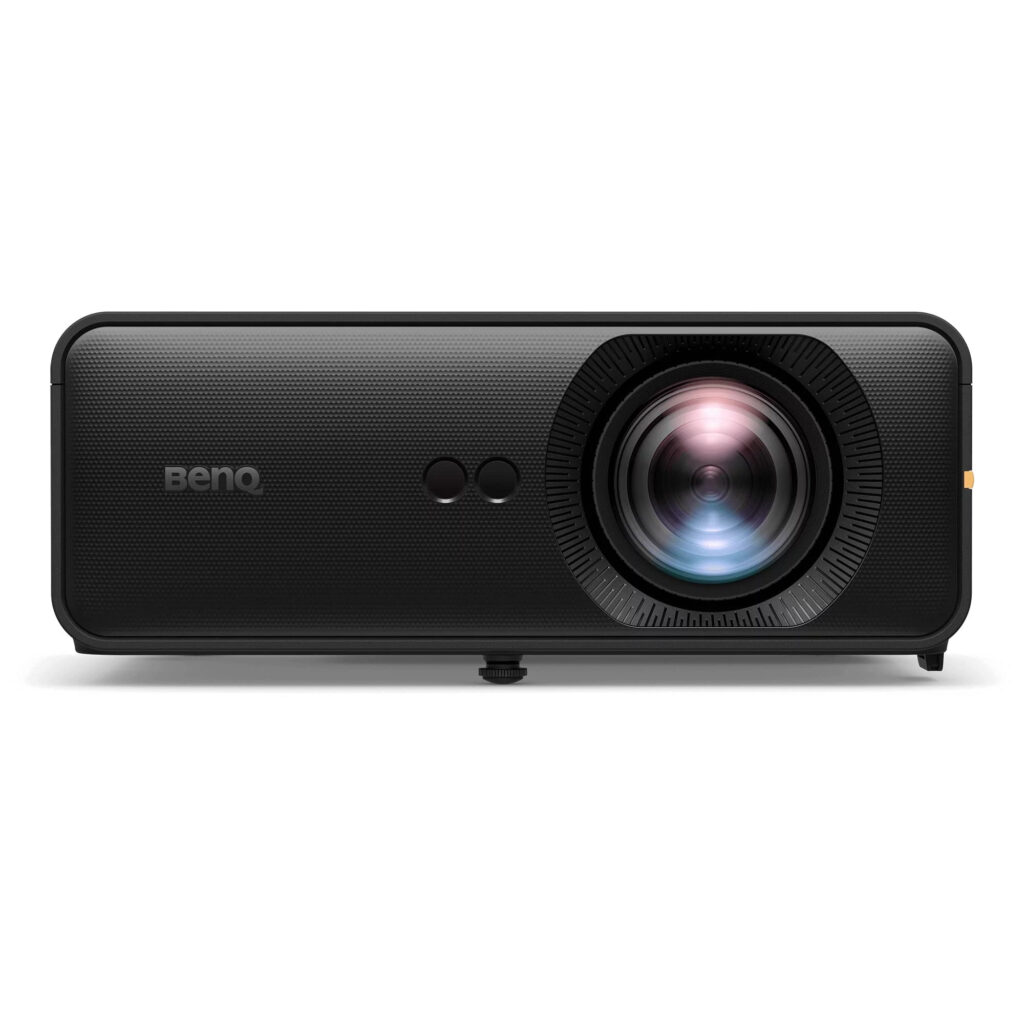
How has the golf simulator projector landscape changed over recent years?
The golf simulator projector market has shifted dramatically since the early 2020s. Here’s how today’s options compare to just a few years ago:
- Throw Ratios Refined
- Then: Guides often recommended 0.4–1.0 as the target range.
- Now: Experience and manufacturer testing have narrowed the sweet spot to 0.5–1.1, with 0.8:1 widely agreed as optimal. The lower bound (0.4) is now considered “ultra-short throw” and less practical for golf.
- Technology Advances
- Then: Most projectors used traditional lamps, required manual calibration, and offered only basic keystone correction.
- Now: Laser light sources with 20,000+ hour lifespans are standard, and features like Auto Screen Fit make setup nearly plug-and-play.
- Resolution and Brightness
- Then: 1080p was standard, and 4K was considered prohibitively expensive. Typical brightness was ~3,000 lumens.
- Now: Affordable 4K UHD projectors like the BenQ AK700ST are mainstream, with 4,000+ lumens brightness to handle ambient light.
- Pricing Reality
- Then: A decent short-throw model could be found for $700.
- Now: Expect to spend $1,100–$5,000+ for a golf-ready projector with modern specs. The higher cost reflects advanced optics, laser engines, and golf-specific tuning.
Overall, what was once a niche setup relying on improvised solutions has matured into a defined product category, with manufacturers like BenQ leading the way.
Can a Zoom Lens Fix Throw Ratio Problems?
Some projectors include optical zoom lenses that let you slightly increase or decrease image size without moving the unit. Others use digital zoom, which adjusts the image electronically.
However, zoom has limits:
- A long throw projector with zoom usually can’t shrink the image enough for a golf simulator screen.
- Digital zoom often reduces brightness and clarity, making it a poor substitute for proper placement.
- Optical zoom adds flexibility but is typically found on higher-end models.
For golf simulators, it’s best to choose a projector with the right native throw ratio (around 0.8:1) rather than relying on zoom to “fix” distance issues. Use zoom only for fine adjustments, not as the primary solution.
Can I Just Buy a Different Lens?
A few high-end projectors offer interchangeable lenses, letting you swap a standard lens for a short-throw option. In theory, this can turn a standard throw projector into one suitable for golf simulation.
In practice, it’s rarely the best path:
- Limited availability: Only certain professional-grade projectors support lens swaps.
- High cost: Replacement lenses often cost $1,000+, sometimes nearly as much as a new short-throw projector.
- Complex installation: Changing lenses isn’t always straightforward and can void warranties if not done correctly.
For most golfers, it makes more sense to buy a purpose-built short throw projector — like the BenQ AH700ST or AK700ST (0.69–0.83:1) — rather than trying to retrofit an existing model. The latest 2024–2025 golf-ready projectors are designed for easy setup, safety, and image quality straight out of the box.
What other projector considerations do I need to make for my golf simulator?
Don’t rush to buy your short throw projector without making sure it meets the other requirements of a simulator projector.
- Project a resolution you’re happy with – 4K golf simulator (short throw) projectors used to be prohibitively expensive but are now commonplace in the 2025 golf simulator market.
- Project an image brightness that is suitable for your simulator room. Do you have any natural light coming in? Will you have the lights down? Will you have them on?
- Project an image with your desired aspect ratio.
- If you’re struggling to find a central position to mount your projector, or you’re considering a floor mount setup, you will need keystone correction. There are projectors that can perform lateral or vertical keystone correction or both. This is imperative if your projector will be positioned anywhere but an above and central location.
Check out my dedicated article all about golf simulator projector mounting positions and placement.
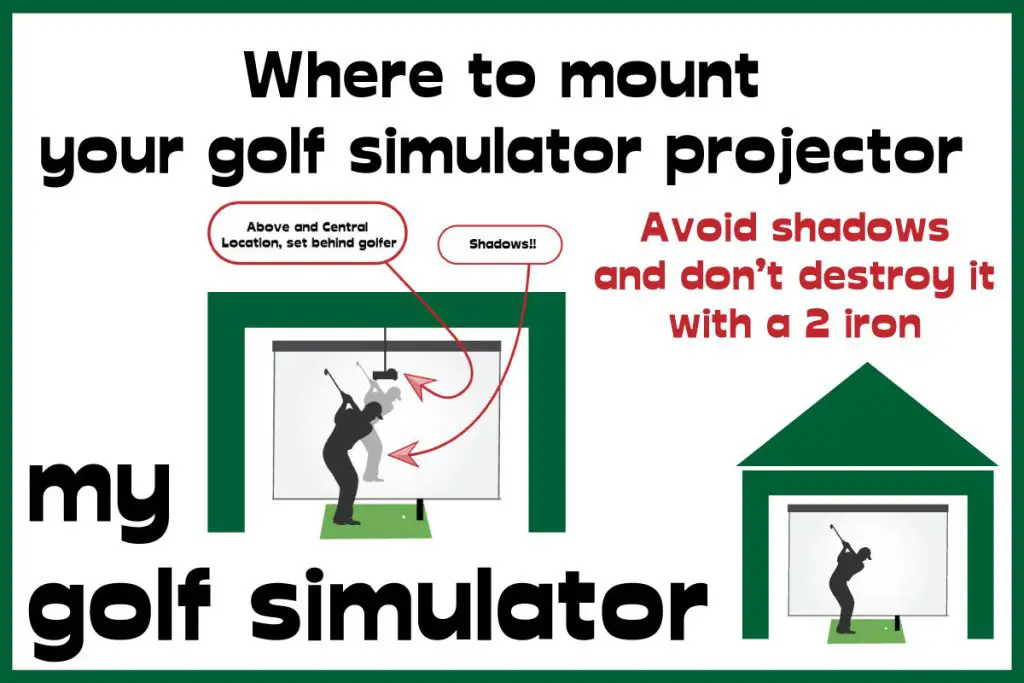
Conclusion and further resources
Choosing the right projector throw ratio is one of the most important steps in building a great golf simulator. With today’s technology, the 0.5–1.1:1 range (0.8:1 sweet spot) offers the best balance of image size, safety, and room flexibility. Models like the BenQ AH700ST and AK700ST make setup easier than ever with laser light sources, auto-calibration, and golf-specific design features.
To get the most out of your setup, check out our related guides on room size requirements, impact screens, and golf simulator lighting. These will help you plan a simulator space that looks great, performs flawlessly, and lasts for years.
If you found this guide helpful, please consider sharing it with other golfers or in your favorite simulator forum — it really helps support the site and keeps resources like this free.
FAQs
What is throw ratio in simple terms?
Throw ratio is the relationship between how far your projector is from the screen (throw distance) and how wide the image is.
Formula: Throw Ratio = Throw Distance ÷ Screen Width.
What throw ratio is best for a golf simulator?
The ideal range is 0.5–1.1:1, with 0.8:1 widely considered the sweet spot. This lets you mount the projector 8–14 ft from the screen, behind the tee area, without casting shadows.
Why can’t I use a standard throw projector?
Standard throw projectors (ratios of 1.5–2.0+) would need 20–30 ft of distance to fill a 15 ft screen. Most simulator rooms aren’t that deep, and placing the projector far back risks shadows and strike damage.
Is ultra-short throw (UST) good for golf simulators?
Ultra-short throw projectors (<0.4:1) are designed to sit just inches from the screen. While they work for classrooms and offices, they are not ideal for golf — they often require floor mounting, need bulky protective enclosures, and can distort the image on impact screens.
Does screen size affect the throw ratio I need?
Yes. The throw ratio is always relative to your screen width. For example, with a 0.8:1 projector:
- A 10 ft wide screen needs ~8 ft throw distance.
- A 15 ft wide screen needs ~12 ft throw distance.
Can zoom lenses change the throw ratio?
Not really. Zoom provides only a small adjustment range. For golf simulators, you should always choose a projector with the right native throw ratio rather than relying on zoom to fix placement.
How does throw ratio affect shadows?
A projector placed too far back (high throw ratio) increases the chance of your body casting shadows. A shorter throw ratio lets you mount closer to the screen, keeping the projector light path clear of your swing.
What’s more important: throw ratio or resolution?
For golf simulators, throw ratio comes first — without the right placement, you’ll get shadows, poor alignment, or even damaged equipment. Resolution and brightness matter too, but you must start with a throw ratio in the correct range.
Mevo Gen 2 Space Requirements
Gray Impact Screens – Pros and Cons
ABOUT THE AUTHOR
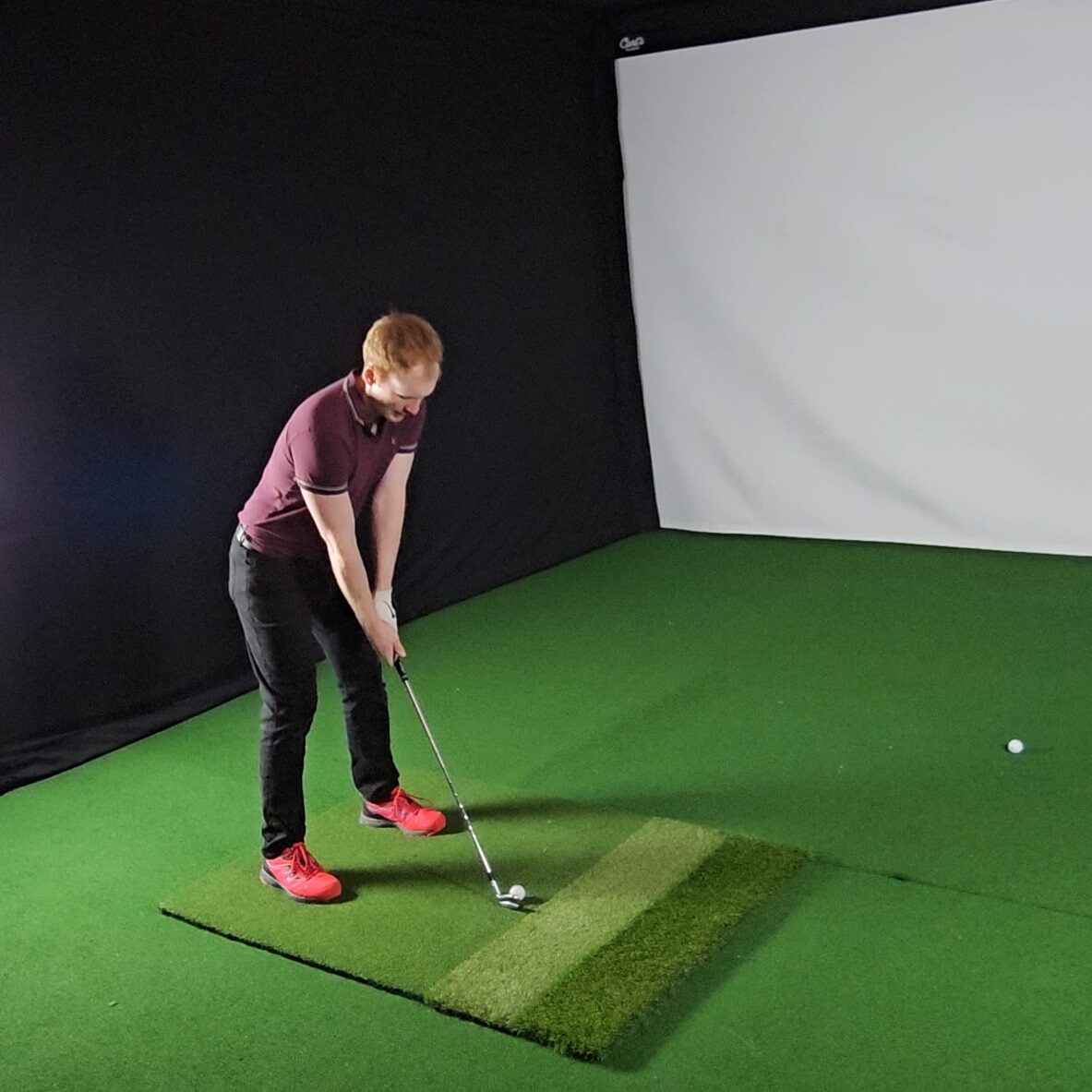
Hello! My name is Alex and it is my mission to bring you all the information you need to build your own home golf simulator! I hope mygolfsimulator.com helps you on your journey to better golf at home!
LEGAL INFORMATION
On this site, you'll find articles on all aspects of building a golf simulator. I will also link to other sites where you can buy some of the simulator components. Some of these links may be affiliate links, which means if you click them I gain a small commission at no extra cost to you. This really helps out me and my site so thank you in advance! mygolfsimulator.com and all related social media accounts are property of Awonline LTD.
